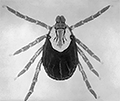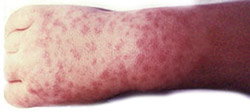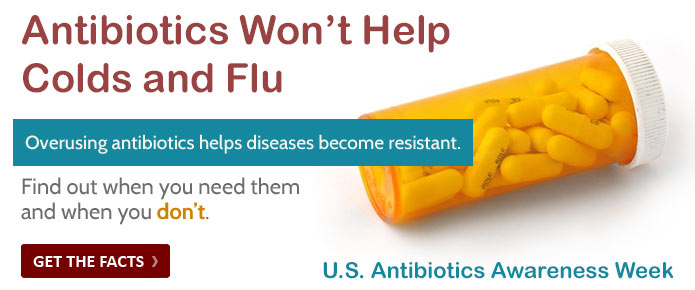
Rocky Mountain spotted fever (RMSF) is a potentially fatal infectious disease transmitted to humans by the bite of an infected tick. The disease occurs throughout the United States during months when ground temperatures reach 40 degrees Fahrenheit or more and ticks are active.
In spite of the disease's name, few cases have been reported from the Rocky Mountain region of the United States. Up to 100 probable cases of RMSF are identified each year in Mississippi.
How RMSF Spreads
Rocky Mountain spotted fever is spread by the bite of an infected tick (the common American dog tick or the lone-star tick) or by contamination of the skin with tick blood or feces. It is not a contagious disease: person-to-person transmission does not occur.
Rocky Mountain spotted fever affects both children and adults bitten by disease-carrying ticks. The risk of RMSF is highest among those exposed to tick-infested habitats or pets.
Symptoms
Symptoms usually appear between 3 and 14 days after the bite of an infected tick. Infection is characterized by the sudden onset of moderate to high fever lasting up to three weeks, severe headache, fatigue, deep muscle pain, chills and sometimes a rash. When present, the rash begins on the legs or arms, may include the soles of the feet or palms of the hands and may spread rapidly to the trunk or the rest of the body. Rocky Mountain spotted fever can be a severe or even fatal illness if not treated in the first few days of symptoms.
 Sole of the foot with advanced RMSF rash
Sole of the foot with advanced RMSF rash
Any person experiencing illness with a fever following a tick bite should consult his or her physician and advise the physician of the tick bite.
Severity
Early treatment with antibiotics lowers the risk of death to between 3 and 5 percent. Untreated cases have a 13 to 25 percent rate of death. Death primarily occurs when the diagnosis is not made until the second week of illness.
Prevention
Persons spending time outdoors in areas where ticks are commonly found – wooded areas, tall grass and brush – should take precautions against all tick-borne diseases:
- Check your clothing often for ticks climbing toward open skin. Wear white or light-colored long-sleeved shirts and long pants so the tiny ticks are easier to see. Tuck long pants into your socks and boots. Wear a head covering or hat for added protection.
- Apply insect repellent containing DEET (30 percent or less) to exposed skin (except the face). Repellents containing permethrin can be applied to outer clothing while in locations where ticks may be common. Follow label directions; do not misuse or overuse repellents. Always supervise children in the use of repellents.
- Walk in the center of trails so weeds do not brush against you.
- Check yourself, children and other family members every two to three hours for ticks. Most ticks are slow to attach, and rarely transmit disease until they have been attached for several hours.
- If you let your pets outdoors, check them often for ticks. Ticks can enter the home on pets and fall off in search of a host.
- Keep your grass mowed and keep weeds cut to keep the area unattractive to ticks.

